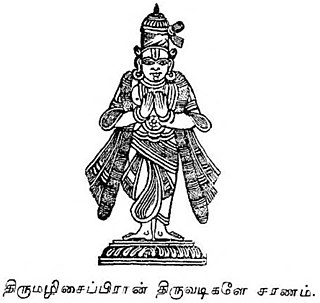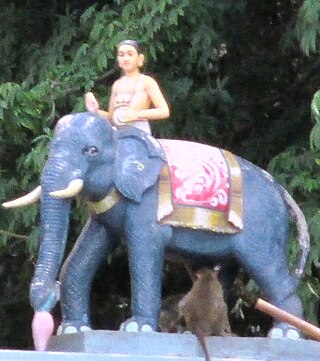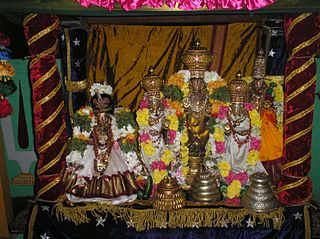
Venkateswara, also known as Venkatachalapati, Balaji and Srinivasa, is a Hindu deity, described as a form or avatar of the god Vishnu. He is the presiding deity of Venkateswara Temple, Tirupati. His consorts, Padmavathi and Bhudevi, are avatars of the goddess Lakshmi, the consort of Vishnu.

The Naalayira Divya Prabandham is a collection of 4,000 Tamil verses composed by the 12 Alvars. It was compiled in its present form by Nāthamuni during the 9th–10th centuries. The work, an important liturgical compilation of the Tamil Alvars who lived between 5th and 8th Century CE, marks the beginning of the canonisation of 12 Vaishnava poet saints, and these hymns are still sung extensively today. The works were lost before they were collected and organised in the form of an anthology by Nāthamuni.

Andal, also known as Godhai, Nachiyar, and Godhadevi, was the only female Alvar among the twelve Hindu poet-saints of South India. She was posthumously considered an avatara of the goddess Lakshmi. As with the Alvar saints, she was affiliated with the Sri Vaishnava tradition of Hinduism. Active in the 8th-century CE, Andal is credited with two great Tamil works, Tiruppavai and Nachiyar Tirumoli, which are still recited by devotees during the winter festival season of Margali. Andal is a prominent figure for women in South India and has inspired several women's groups such as Goda Mandali.

Divya Desam or Vaishnava Divya Desams are the 108 Vishnu and Lakshmi temples that are mentioned in the works of the Alvars, the poet-saints of the Sri Vaishnava tradition.

The Tiruppavai is a set of Tamil Hindu hymns attributed to the female poet-saint Andal.

Koodal Aḻagar Temple in Madurai, a city in the South Indian state of Tamil Nadu, is a temple dedicated to the Hindu god Vishnu. Constructed in the Dravidian style of architecture, the temple is glorified in the Naalayira Divya Prabandham, the early medieval Tamil canon of the Alvar saints from the 6th–9th centuries CE. It is one of the 108 Divya Desams dedicated to Vishnu, who is worshipped as Viyooga Sundarrajan, and his consort Lakshmi as Mathuravalli.

Tirumalisai Alvar is a Tamil saint revered in the Sri Vaishnavism school of south India, in Tondai Nadu. He was born in 4203 BCE. The legend of this saint devotees of Sri Vaishnavism believe that he was the incarnation of Vishnu's disc, Sudarshana. He is believed to have been born at the Jagannatha Perumal temple, Tirumalisai, by "divine grace".

Periyalvar, also known as Vishnuchittar, was one of the twelve Alvar saints of South India who are known for their affiliation to the Vaishnava tradition of Hinduism. He was the foster father of Andal. Andal, also called as Kodhai, is the only female Alvar, and is considered to be the incarnation of Bhudevi according to Sri Vaishnavism.

Oppiliappan Temple, is a Hindu temple dedicated to Vishnu, located near Thirunageswaram and also known by its old toponym Thiruvinnagar, a village in the outskirts of the Kumbakonam in the South Indian state of Tamil Nadu. Constructed in the Dravidian style of architecture, the temple is glorified in the Naalayira Divya Prabandham, the early medieval Tamil canon of the Alvar saints from the 6th–9th centuries CE. It is counted as the 60th of the 108 Divya Desams dedicated to Vishnu. Vishnu is worshiped as Oppiliappan and his consort Lakshmi as Bhudevi.

Azhagiya Manavalan Perumal Temple in Uraiyur, a suburb Tiruchirappalli in the south Indian state of Tamil Nadu, is dedicated to the Hindu God Azhagiya Manavalan (Vishnu) and Goddess Kamalavalli (Lakshmi). Constructed in the Dravidian style of architecture, the temple is glorified in the Divya Prabandha, the early medieval Tamil canon of the Alvar saints from the 6th–9th centuries CE. It is one of the 108 Divyadesam dedicated to Lakshmi Narayana.

The Deepaprakasa Perumal Temple, also referred to as Tiruththanka, Desikar Avatara Sthalam, and Tooppul, is located in Kanchipuram in the South Indian state of Tamil Nadu, is a temple dedicated to the Hindu god Vishnu. Constructed in the Dravidian style of architecture, the temple is glorified in the Naalayira Divya Prabandham, the early medieval Tamil canon of the Alvar saints from the 6th–9th centuries CE. It is one of the 108 Divya Desams dedicated to Vishnu, who is worshipped as Deepaprakasar, and his consort Lakshmi as Maragathavalli. This is the 3rd largest temple in southern Kanchipuram.

Thiru Anbil, or Sundararaja Perumal Temple, in Anbil, a village in the outskirts of Tiruchirappalli in the South Indian state of Tamil Nadu, is dedicated to the Hindu god Vishnu. Constructed in the Dravidian style of architecture, the temple is glorified in the Naalayira Divya Prabandham, the early medieval Tamil canon of the Alvar saints from the 6th–9th centuries CE. It is one of the 108 Divya Desams dedicated to Vishnu, who is worshipped as Sundararajan and his consort Lakshmi as Sundaravalli.

Sthalasayana Perumal Temple is a Hindu temple dedicated to the god Vishnu located near Kollumangudi, Tamil Nadu, India. It is located 2 km away from Kollumangudi, 40 km away from Kumbakonam and 10 km from Karaikal. Constructed in the Dravidian style of architecture, the temple is glorified in the Nalayira Divya Prabandham, the early medieval Tamil canon of the Alvar saints from the 6th–9th centuries CE. It is one of the 108 Divya Desams dedicated to Vishnu, who is worshipped as Sthalasayana Perumal and his consort Lakshmi as Thirumagal Nachiyar. A granite wall surrounds the temple, enclosing all the shrines. There is a four-tiered rajagopuram, the temple's gateway tower, in the temple.

Nachiyar Kovil or Thirunarayur Nambi Temple is a Hindu temple in Thirunarayur, a village in the outskirts of Kumbakonam in the southern Indian state of Tamil Nadu, is dedicated to the Hindu god Vishnu and her consort lakshmi. Nachiyar koil is one of 2 divyadesams were Lakshmi is pradaana over Vishnu. Thirunaraiyur is the sub urban region of business city of Kumbakonam.

Sri Srinivasa Perumal Temple or Sri Mayakoothar Permual Temple is one of the Nava Tirupatis, nine Hindu temples dedicated to Vishnu located Perungulam along Tiruchendur-Tirunelveli route, Tamil Nadu, India in the southern bank of Thamiraparani river. It is located 5 km from Alvar Thirunagari. All these 9 temples are classified as Divya Desams, the 108 temples of Vishnu revered by the 12 poet-saints of Sri Vaishnavism called the Alvars. The temple is referred to as Shani sthalam, a location for the planet deity, Shani (Saturn). Constructed in the Dravidian style of architecture, the temple is glorified in the Nalayira Divya Prabandham, the early medieval Tamil canon of the Alvar saints from the 6th–9th centuries CE. It is one of the 108 Divya Desams dedicated to Vishnu, who is worshipped as Mayakoothar and his consort Lakshmi as Kulandhaivalli Tayar.

Niladevi, also rendered as Neela Devi or Nappinnai, is a Hindu goddess, and a consort of the preserver deity Vishnu, along with Sridevi and Bhudevi. Niladevi is primarily revered in South India, particularly in Tamil culture, as one of Vishnu's consorts. In Sri Vaishnava tradition, all three consorts of Vishnu are regarded as aspects of Mahalakshmi.

Nagnajiti, also known as Satya, and Nappinnai, is the fifth of the Ashtabharya, the eight principal wives of the Hindu god Krishna.
Poornavalli Thayar is a Hindu figure. Poornavalli, also called "Poorva Devi", means "the one who filled the grail". Lakshmi is named as Poornavalli. She is the Mother goddess, worshiped in Uthamar Kovil in Uthamar Kovil, a village in the outskirts of Tiruchirappalli in the South Indian state of Tamil Nadu, is dedicated to the Hindu gods Vishnu, Shiva, Brahma. Constructed in the Dravidian style of architecture, the temple is glorified in the Naalayira Divya Prabandham, the early medieval Tamil canon of the Alvar saints from the 6th–9th centuries CE. It is one of the 108 Divyadesams dedicated to Vishnu and Lakshmi, where Vishnu is worshiped as Purushottama Perumal and his consort Lakshmi as Poornavalli Thayar.

The Āmuktamālyada is a Telugu epic poem composed by Krishnadevaraya, the ruler of the Vijayanagara Empire, in the early 16th century. Amuktamalyada translates to "One who offered the garland after wearing it herself". Considered as a masterpiece, the Amuktamalyada describes the legendary wedding of the Hindu deity Ranganayaka, an avatar of Vishnu, and Andal, one of the poet-saints called the Alvars, at Srirangam.

The Perumal Tirumoli is a work of Tamil Hindu literature written by Kulasekhara Alvar, one of the Alvars, the poet-saints of the Sri Vaishnava tradition. This work, which is a part of the Nalayira Divya Prabandham, consists of 105 hymns, that are numbered 647 to 750 in the compendium. It is dedicated to the worship of Vishnu, who is referred to as Perumal.




















